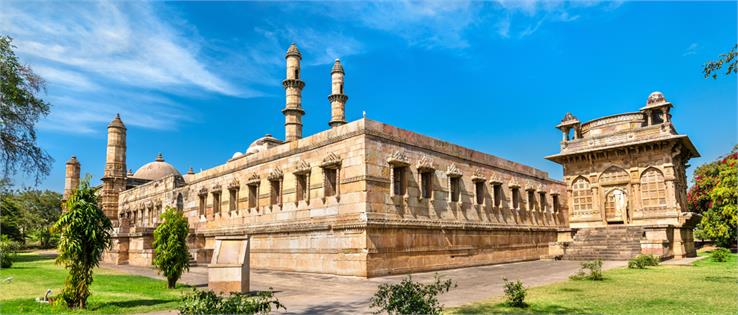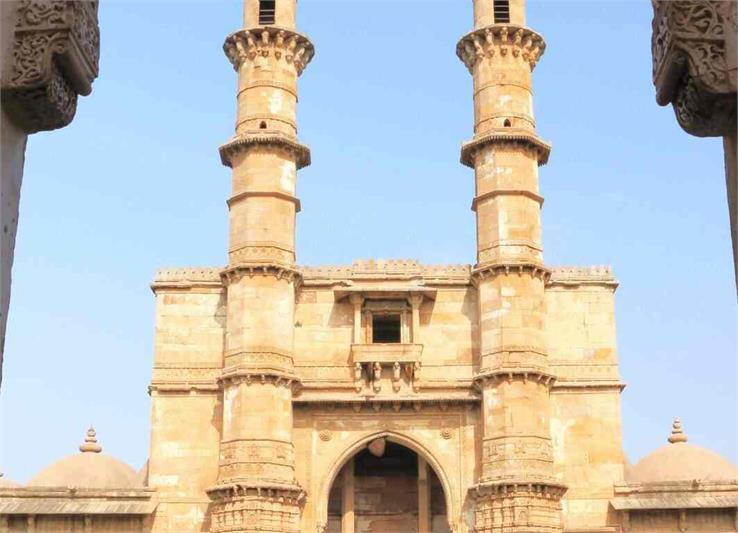Champaner-Pavagadh A Must-Visit Site In Gujarat!

The Champaner-Pavagadh Archaeological Park, nested in Gujarat, India, is a UNESCO World Heritage Site. This Archaeological Park, with its ancient ruins, stunning architecture, and sacred pilgrimage sites, offers visitors a captivating journey through time and a unique blend of Hindu and Islamic influences. Explore its historical significance, architectural wonders, and spiritual aura that continue to draw travelers worldwide.
Also Read: UNESCO World Heritage Sites of India
Who built Champaner-Pavagadh fort?
Sultan Mahmud Begada, Ahmed Shah's grandson and founder of Ahmedabad city, built the Champaner-Pavagadh fort. The fort was built in the 16th century and served as a strategic military base for the Gujarat Sultanate. The fort complex houses several historical and cultural monuments, including palaces, mosques, tombs, temples, and water installations such as step-wells and tanks.
Also Read: The Best Places To Visit In Gujarat
A Historical Tapestry
The Champaner-Pavagadh Archaeological Park is a living testament to the ebb and flow of history in the Indian subcontinent. The story begins in the 8th century when Champaner was founded as a regional capital under the Chavda dynasty. Over the centuries, it changed hands and allegiances, eventually coming under the sway of the Gujarat Sultanate in the 15th century under the rule of Sultan Mahmud Begada.
The park boasts a stunning array of historical structures that reveal the multifaceted layers of its past. The architecture reflects the cultural exchange during this period. The Jami Masjid, an imposing mosque built in 1513 CE, is a prime example of this architectural fusion. Its grand entrance is adorned with intricate floral motifs, while the central courtyard showcases striking Islamic calligraphy.
Also Read: Buddhist Monuments at Sanchi
Architectural Marvels
The archaeological park is a treasure trove of architectural marvels, each with its unique story. Among the most prominent structures is the Sahar ki Masjid, known for its exquisitely carved mihrab (prayer niche) and elaborately designed pillars. The Kevda Masjid stands out for its three imposing domes and beautifully crafted stonework, and the Nagina Masjid, with its finely detailed lattice screens, exudes an air of elegance.
As you wander through these ancient corridors, you will be transported back in time, where the echoes of prayer and the whispers of history seem to reverberate through the stones. The intricate carvings, graceful arches, and symmetrical layouts of these structures are a testament to the architectural prowess of the artisans of the time.
Also Read: Qutub Minar
A Spiritual Sanctuary - Pavagadh Hill
While the archaeological treasures of Champaner are undoubtedly captivating, Pavagadh Hill adds a spiritual dimension to the experience.
The hill, also known as the Pavagadh-Kalika Temple, is sacred to Hindus and is a significant pilgrimage site. The Kalikamata Temple, perched atop the hill, is dedicated to the goddess Kali and is a place of immense reverence and spirituality.
Visitors can undertake a steep climb, a challenging yet rewarding endeavor that allows you to immerse yourself in the natural beauty of the hill. Alternatively, a cable car ride is available, providing breathtaking panoramic views of the surrounding landscape.
The temple's architecture blends traditional Hindu styles, and it houses an idol of the goddess Kali, believed to be extremely powerful and benevolent. The atmosphere is serenity and devotion, making it a place of solace and reflection for pilgrims and tourists alike.
UNESCO World Heritage Recognition
In 2004, the Champaner-Pavagadh Archaeological Park received the prestigious UNESCO World Heritage Site designation, further underscoring its cultural and historical significance. This recognition has brought increased attention to the site, and conservation efforts have intensified. The Archaeological Survey of India (ASI) plays a crucial role in preserving and restoring the park's architectural treasures, ensuring that future generations can continue to marvel at its splendor.
Visitor Experience
For those planning a visit to the Champaner-Pavagadh Archaeological Park, it is advisable to allocate a full day to explore the site thoroughly. The best time to visit is during the cooler months, from October to March, to enjoy a comfortable and pleasant experience.
To make the most of your visit, consider hiring a local guide who can provide historical context and insights into the significance of each structure.
Additionally, comfortable clothing and sturdy footwear are recommended, especially if you plan to trek up Pavagadh Hill.
The Champaner-Pavagadh Archaeological Park is a living testament to India's rich and diverse history. It invites travelers on a journey through time, where they can marvel at the architectural wonders that witness the fusion of cultures, the rise and fall of dynasties, and the enduring spirituality that permeates the land.
As a UNESCO World Heritage Site, this archaeological park preserves the past and serves as a bridge between generations, connecting us to the vibrant tapestry of India's heritage. Whether you are a history enthusiast, an architecture lover, or a seeker of spiritual experiences, the Champaner-Pavagadh Archaeological Park is a destination that promises to leave an indelible mark on your heart and soul.











